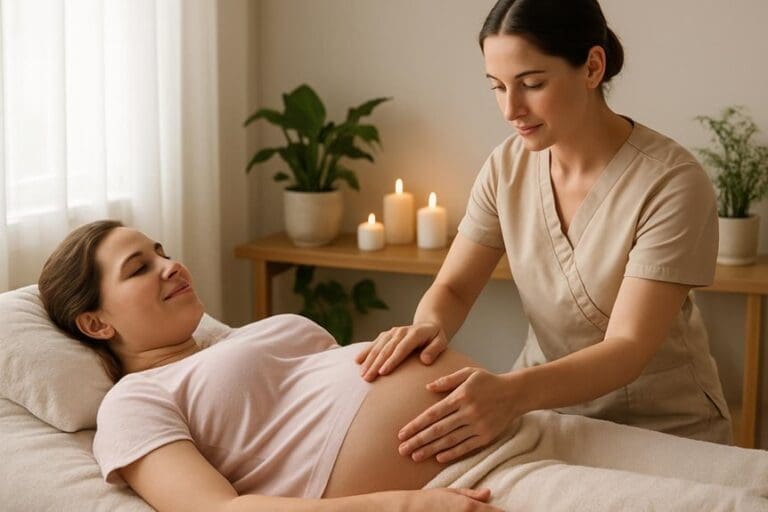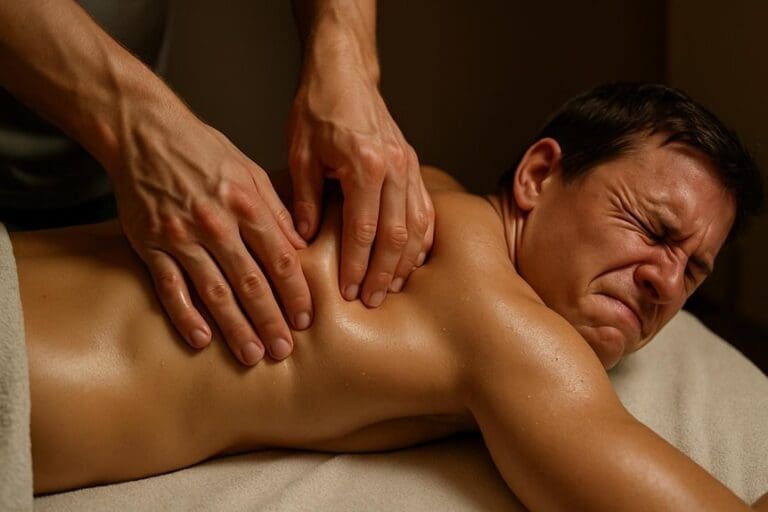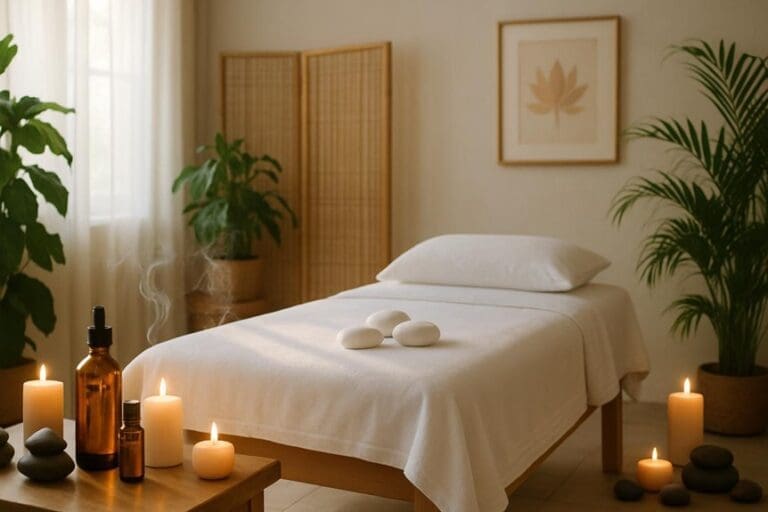Most people can resume light movement 60–90 minutes after an aromatic massage. Moderate exercise is best delayed 3–4 hours. Intense workouts, heavy lifting, or intervals should wait 12–24 hours to protect tissues and support the parasympathetic response. Gentle walking or breath-led stretching suits those feeling stiff; rest is appropriate if drowsy. Hydration and skin care matter when essential oils were used. Watch for unusual fatigue, soreness, or dizziness. Those seeking tailored return-to-training guidance will find practical steps ahead.
How Essential Oil Massage Affects Your Body and Energy Levels
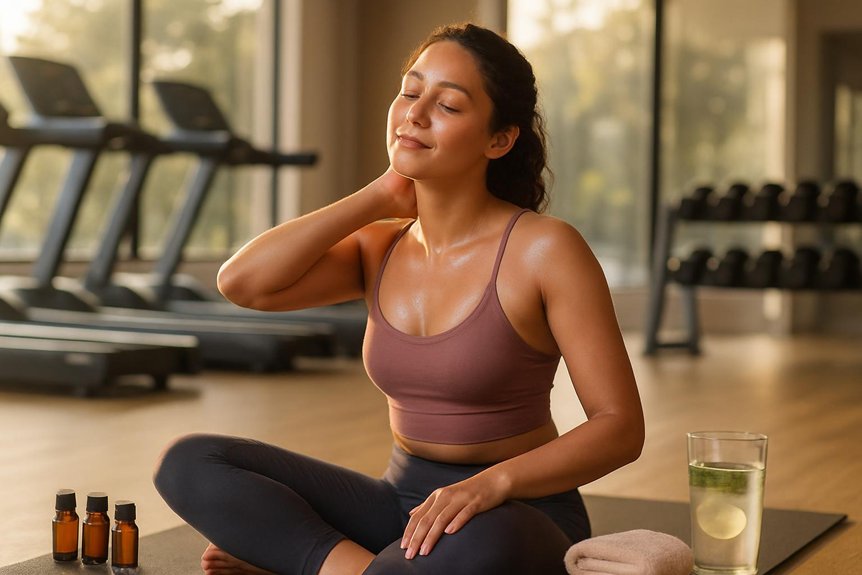
How does an aromatherapy massage shift the body’s state and energy across the day? Evidence suggests targeted touch combined with essential oils modulates the autonomic nervous system, easing sympathetic drive while enhancing parasympathetic tone.
In Spa & Massage clinics, therapists select oils—such as lavender for calm or rosemary for mental clarity—based on client goals and sensitivities. Gentle to moderate pressure supports circulation, reduces perceived muscle tension, and may improve sleep quality through lowered cortisol and improved heart rate variability.
Clients often notice a soft, grounded alertness: lighter limbs, steadier breathing, and a clearer head. For those seeking intimacy with their own rhythms, this treatment nurtures a quiet focus in the morning and a settling warmth by evening.
The relaxing and healing properties of aromatic massage make it an excellent choice for those looking to support both physical and emotional well-being.
Our therapists recommend hydrating, noticing shifts in mood and body, and responding with kindness to changing energy.
Ideal Waiting Time Before Light, Moderate, and Intense Workouts
A practical window between aromatic massage and exercise helps protect tissues and maximise benefits.
Based on circulatory, neuromuscular, and skin-absorption responses observed after massage, Spa & Massage therapists generally advise: light activity (easy walking, gentle mobility) after 60–90 minutes, moderate training (steady cycling, brisk walk, light strength) after 3–4 hours, and intense sessions (intervals, heavy lifts, competitive sport) after 12–24 hours.
This pacing respects transient reductions in muscle tone, enhanced parasympathetic dominance, and the time needed for carrier oils and essential oils to settle on the skin.
Personalisation matters. Those prone to post-massage light-headedness should start at the longer end of each window and rehydrate.
If soreness or unusual fatigue appears, extend rest. In our clinics, therapists adjust these timelines to session depth, areas treated, and client goals.
Choosing the Right Post-Massage Activity: Walking, Yoga, or Rest
Why choose walking, yoga, or rest after an aromatic massage? Spa & Massage advises selecting the gentlest option that sustains relaxation while supporting circulation and tissue recovery.
A relaxed stroll suits most clients: it stabilises blood pressure, reduces residual heaviness, and helps essential oils continue working without overstimulating the nervous system.
Gentle yoga—think slow, breath-led mobility and supported stretches—benefits those with stiffness who tolerate light movement. Our therapists often suggest 10–20 minutes of restorative poses.
Rest is the right choice when clients feel drowsy, light-headed, or emotionally open; lying down or napping allows parasympathetic effects to consolidate.
Decision guide: choose walking for steady energy and clarity; yoga for supple ease and mindful reconnection; rest for deep integration.
In our London clinics, therapists personalise this choice to each client’s goals and sensitivity.
Hydration, Nutrition, and Breathing Tips After Your Session
Soon after an aromatic massage, Spa & Massage recommends a simple protocol: hydrate, refuel lightly, and breathe with intention to stabilise the nervous system.
Water or warm herbal infusions support circulation and help metabolise essential oils; they suggest sipping 300–500 ml over the first hour, avoiding alcohol and very sweet drinks.
Many clients prefer a light snack within 30–60 minutes—fruit, yoghurt, nuts, or a small protein portion—balancing carbohydrates and protein to steady energy without taxing digestion.
Their therapists guide clients to brief diaphragmatic breathing: inhale through the nose for four counts, exhale for six, for five minutes.
This lengthened exhale encourages vagal tone, easing post-treatment heaviness.
Those sensitive to scents can step into fresh air, continue slow breaths, and observe gentle thirst cues.
When It’s Safe to Return to Strength Training and Cardio
While post-massage relaxation lingers, Spa & Massage advises clients to wait before intense exercise to allow parasympathetic recovery and ideal tissue adaptation.
For most healthy adults after aromatic massage, light movement—gentle walking and mobility work—is appropriate within 2–4 hours. Returning to structured cardio at low-to-moderate intensity is typically safe after 12–24 hours, building gradually.
Strength training that loads recently treated tissues is best resumed after 24 hours; 36–48 hours may suit deeper work or sensitive areas.
Evidence suggests massage temporarily reduces neuromuscular tone and alters pain perception; delaying maximal effort helps preserve range gains and prevents compensations.
In our clinics, therapists encourage a warm-up that feels unhurried, submaximal sets first, and conservative volume.
Clients following phased progression report steadier performance and fewer flare-ups.
Signs You’re Overdoing It and How to Adjust Your Routine
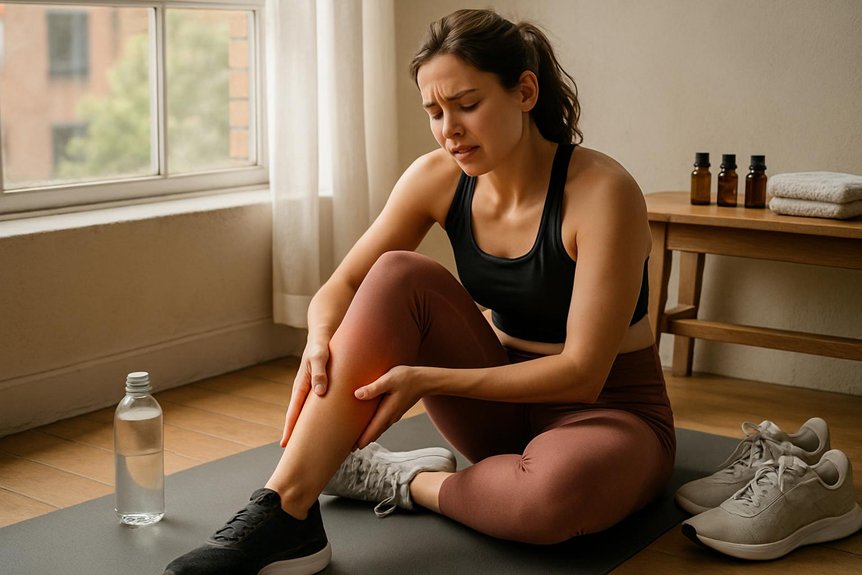
After aromatic massage, key warning signs of overdoing it include unusual fatigue, lingering soreness beyond 24–48 hours, light-headedness, or swelling in worked areas.
When these occur, Spa & Massage therapists advise lowering training intensity by 10–30%, extending rest between sessions, prioritising mobility and low-impact cardio, and increasing hydration and protein intake.
If symptoms persist or worsen, they recommend pausing strenuous exercise and booking a follow-up to reassess recovery needs and technique.
Post-Massage Warning Signs
A measured approach to exercise after an aromatic massage helps prevent overexertion, and several warning signs indicate when adjustment is needed.
Common red flags include lingering dizziness, headache, nausea, or excessive thirst—often signals of dehydration or nervous system overload. Localised soreness that sharpens during movement, joint pain rather than muscular stiffness, or swelling suggests the intensity was too high.
Unusual fatigue, sleep disruption, or elevated resting heart rate the next morning also merit caution.
At Spa & Massage, therapists advise clients to monitor these cues for 24–48 hours. Gentle walking and breath-led mobility are preferred if symptoms appear.
If there’s tingling, numbness, chest pain, or shortness of breath, activity should stop and medical advice sought.
Hydration, light protein intake, and calm pacing support recovery between sessions.
Smart Training Adjustments
Curiously, the body often signals overtraining before performance drops: persistent muscle soreness beyond 48 hours, reduced range of motion, irritability, poor sleep, or an elevated resting heart rate. These signs suggest the nervous system needs a gentler load.
Smart adjustments include reducing intensity by 20–30%, prioritising low-impact zones (RPE 4–6), and shortening sessions to preserve quality. Alternate hard days with recovery work—mobility, easy cycling, or walking.
Emphasise technique over volume, with longer warm-ups and calm nasal breathing to regulate stress.
After aromatic massage at Spa & Massage, therapists advise a 24-hour window of light movement, then a stepwise return: mobility, activation, then strength. Hydration, protein-timed meals, and consistent sleep anchor recovery.
If warning signs persist beyond a week, our clinicians recommend reassessment and a tailored plan.
How Our Therapists Personalise Aftercare for Active Clients
Tailored aftercare begins with a brief assessment of the client’s activity profile—training frequency, sport type, upcoming events, and any injury history—so guidance aligns with goals and recovery timelines.
At Spa & Massage, therapists then adjust recommendations based on pressure response, tissue sensitivity, and autonomic cues observed during the aromatherapy session. They suggest a 12–24 hour window before high-intensity work, favouring light mobility, breath-led stretching, and gentle walks to consolidate parasympathetic effects.
Hydration advice is specific: steady fluids, electrolyte balance if training resumes, and avoiding alcohol.
Where essential oils are used in our clinics, clients are guided on skin care, heat exposure, and timing of showers.
For runners, cyclists, and lifters, therapists map phased return plans, highlight red flags, and schedule follow-ups to refine recovery.
Conclusion
In closing, the guidance is simple yet nuanced: timing matters, intensity matters, and how one feels matters most. Like a metronome setting the pace, thoughtful aftercare keeps benefits in rhythm—light movement first, then progressive training as comfort returns. With hydration, nutrition, and breathwork supporting recovery, clients can respect signals of strain and recalibrate. Backed by therapist-informed practice, this balanced approach helps individuals protect gains from aromatic massage while safely returning to exercise aligned with their goals and wellbeing.

